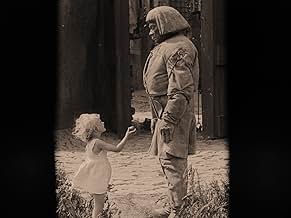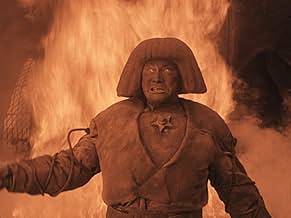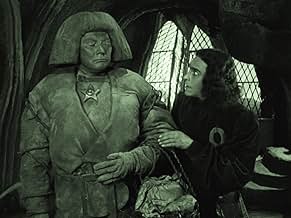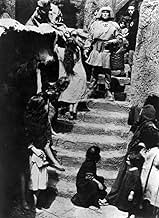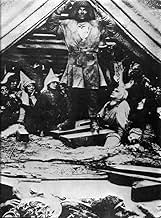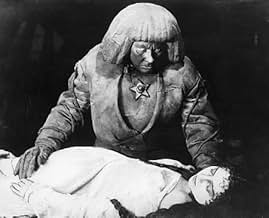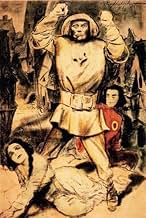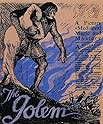IMDb RATING
7.2/10
9.1K
YOUR RATING
In 16th-century Prague, a rabbi creates the Golem - a giant creature made of clay. Using sorcery, he brings the creature to life in order to protect the Jews of Prague from persecution.In 16th-century Prague, a rabbi creates the Golem - a giant creature made of clay. Using sorcery, he brings the creature to life in order to protect the Jews of Prague from persecution.In 16th-century Prague, a rabbi creates the Golem - a giant creature made of clay. Using sorcery, he brings the creature to life in order to protect the Jews of Prague from persecution.
- Directors
- Writers
- Stars
- Awards
- 1 win & 1 nomination total
Hans Stürm
- Der Rabbi Jehuda, der Älteste der Gemeinde
- (as Hans Sturm)
Carl Ebert
- Temple Servant
- (uncredited)
Fritz Feld
- Jester
- (uncredited)
Loni Nest
- Ein kleines Mädchen
- (uncredited)
- …
Ursula Nest
- Little Girl
- (uncredited)
Dore Paetzold
- Des Kaisers Kebse
- (uncredited)
- …
Märte Rassow
- Kind
- (uncredited)
- Directors
- Writers
- All cast & crew
- Production, box office & more at IMDbPro
Featured reviews
Imagine shooting a feature-length horror movie with the camera built into your mobile phone. Now imagine disabling sound and colour on your phonecam, only being able to shoot a few seconds at a time, each minute costing a small fortune in recording material, imagine that phonecam being large and unwieldy and kind of knackered so that the already low-resolution image is flickery and erratically exposed, and it plays back too fast so that people look like wound-up dolls. It also exposes blueish light more than reddish light, so each shoot is unpredictable, but of course you'll only know that the next day when the film has been processed.
Welcome to movie-making in the year 1920 AD.
Now go shoot a masterpiece that will still be watched, talked about and revered in a hundred years.
I watched this out of historic interest and expected to be colossally bored. But far from it, this is actually a gripping horror flick, and one with a deep side to it to boot. The Golem himself is an immensely scary horror figure en par with Freddy Kruger or the Alien, kind of a proto-Frankenstein's monster -- and he's actually played by director Paul Wegener himself!. I'd like to know how they made his eyes so scary.
Anyway, what can I say, a stupendous film. Watch it from the edge of your seat.
Welcome to movie-making in the year 1920 AD.
Now go shoot a masterpiece that will still be watched, talked about and revered in a hundred years.
I watched this out of historic interest and expected to be colossally bored. But far from it, this is actually a gripping horror flick, and one with a deep side to it to boot. The Golem himself is an immensely scary horror figure en par with Freddy Kruger or the Alien, kind of a proto-Frankenstein's monster -- and he's actually played by director Paul Wegener himself!. I'd like to know how they made his eyes so scary.
Anyway, what can I say, a stupendous film. Watch it from the edge of your seat.
When I see these old attempts at what amounted to a horror film back then, before my time and I'm an old duffer, I'm always struck at the marvelous Gothic quality wrought by the twisted buildings, the gnarled stairways, the open balconies and the weird angles of things such as doorways, arches, street, bridges and the like. The monstrosities are stark, hardly terrifying by today's CGIs and often terrifying their victims in an almost comical, stylized way. This marvelous film together with Nosferatu and The Cabinet of Dr. Caligari are marvelous pieces of art. There is an ageless quality to them that transcends the hoary and often corny plots and acting. Each must be taken as a whole because that product is always greater than the sum of their parts. Compare the magical Indian Love Call of Nelson Eddy and Jeanette MacDonald, two rather mainstream singers whose voices blend into something greater than either of their individual talents. So too it is, I contend, with these old Gothic classics. Horror? Hardly. But, their starkness and darkness with its twisted surroundings are still eerie and provoking.
I caught this restored version of the 1920 German silent classic at Lincoln Center where a new musical score was premiered by the Chamber Music Society. I had never seen the film before and was frankly amazed at the imagery in the sets and costumes and editing of the film. The film's director, Paul Wegener, wearing a thickly padded outfit and wig and high-heeled boots plays the main character, "The Golem". A mythical character from Jewish folklore. For its day, the special effects were also intriguing. I resist describing the movie as anti-semitic but I believe that the portrayal of the jewish ghetto was depicted so dramatically to show that the jews in Prague were outsiders and not welcome in mainstream society. This is evident in the fact that when a nobleman comes to the ghetto, he is greeted by a mammoth closed gate that looks like a precursor to the one used in King-Kong. And most notably, during the creation sequence, a satanic figure appears on screen that would coincide with the European belief a that time that Jews walk hand-in-hand with the Dark forces.
As far as the Golem's performance- this film is really a precursor to "Frankenstein" that Boris Karloff must have seen in its original release - there are so many similarites.
Biggest Image - at the conclusion, the Golem is surrounded by a group of "blond" Aryan-looking children that clearly distinguish them from the ghetto children that we see earlier in the film.
As far as the Golem's performance- this film is really a precursor to "Frankenstein" that Boris Karloff must have seen in its original release - there are so many similarites.
Biggest Image - at the conclusion, the Golem is surrounded by a group of "blond" Aryan-looking children that clearly distinguish them from the ghetto children that we see earlier in the film.
In 16th-century Prague, a Jewish rabbi (Albert Steinrück) creates a giant creature from clay, called the Golem, and using sorcery, brings the creature to life in order to protect the Jews of Prague from persecution.
Called "one of the most ambitious productions of the silent era" by Mike Mayo, the film is a blend of religion, astrology and black magic -- mixing Judaism with a conjuring of the demon Astaroth.
The film also has an interesting presentation of anti-Semitism, where the emperor accuses the Jews of killing Christ, among other things, and orders them to evacuate the ghetto. How did Germany in 1920 feel about the Jews? We now know how they felt a decade later, but was this hatred always there or invented by Hitler? If it existed, how did it translate to this film's reception by the German people?
Paul Wegener's face is a wealth of visions -- he manages to use his eyes in such a way that present the golem as simultaneously stoic and intensely emotional.
Others have pointed out that Karl Freund's camera is remarkably still for a man who would go on to be known for the most innovative camera techniques in film history (I dare say he is the greatest cinematographer who ever lived). Mayo says there is an "inventive use of extreme camera angles", but I did not notice. The lack of movement does not hinder the film, however.
Lee Price praises the film, saying the only fault of the film is "the inconsistency of the acting", though I did not find it distracting at all (even if the frightened faces of the extras are a bit extreme). Price calls the architecture of the film as influential (or more so) than the German Expressionism of "Caligari". He is not alone in this view: Ivan Butler makes a point to mention the "strange twisted buildings and crooked streets filled with steeple-hatted inhabitants", and Siegfried Kracauer singles out the "maze of crooked streets and stooped houses" devised by Professor Hans Poelzig.
If you are to see or own this film, I recommend the Kino DVD. Not only is the film cleaned up nicely, with a wonderful score and English title cards, but the supplements are beyond what one would expect from such an old film -- featurettes comparing this movie to "Faust" and the later "Le Golem". I enjoyed them.
Called "one of the most ambitious productions of the silent era" by Mike Mayo, the film is a blend of religion, astrology and black magic -- mixing Judaism with a conjuring of the demon Astaroth.
The film also has an interesting presentation of anti-Semitism, where the emperor accuses the Jews of killing Christ, among other things, and orders them to evacuate the ghetto. How did Germany in 1920 feel about the Jews? We now know how they felt a decade later, but was this hatred always there or invented by Hitler? If it existed, how did it translate to this film's reception by the German people?
Paul Wegener's face is a wealth of visions -- he manages to use his eyes in such a way that present the golem as simultaneously stoic and intensely emotional.
Others have pointed out that Karl Freund's camera is remarkably still for a man who would go on to be known for the most innovative camera techniques in film history (I dare say he is the greatest cinematographer who ever lived). Mayo says there is an "inventive use of extreme camera angles", but I did not notice. The lack of movement does not hinder the film, however.
Lee Price praises the film, saying the only fault of the film is "the inconsistency of the acting", though I did not find it distracting at all (even if the frightened faces of the extras are a bit extreme). Price calls the architecture of the film as influential (or more so) than the German Expressionism of "Caligari". He is not alone in this view: Ivan Butler makes a point to mention the "strange twisted buildings and crooked streets filled with steeple-hatted inhabitants", and Siegfried Kracauer singles out the "maze of crooked streets and stooped houses" devised by Professor Hans Poelzig.
If you are to see or own this film, I recommend the Kino DVD. Not only is the film cleaned up nicely, with a wonderful score and English title cards, but the supplements are beyond what one would expect from such an old film -- featurettes comparing this movie to "Faust" and the later "Le Golem". I enjoyed them.
The giant frame of Paul Wegener as the Golem is one of the best known characters from the silent era, and one of the first icons of horror. Der Golem is actually the third film to feature the character, the first being The Golem (1915), and the second The Golem And The Dancing Girl (1917), which is a short comedy with Wegener donning the costume to frighten a girl he is in love with. Tragically, those two films are now considered lost, and only fragments equalling about 14 minutes of the first film remain. This film is actually a prequel, and it's full title is Der Golem: Wie Er In Die Welt Kam (How He Came Into The World), but is now commonly know as simply Der Golem.
The Jews of medieval Prague face persecution from the townsfolk. Terrified of their doomed fate, Rabbi Loew (Albert Steinruck) uses his skills in black magic to create The Golem, a mythical figure from Jewish folklore. He is made entirely from clay, and has an amulet in his chest that gives him power, and when removed turns him back into lifeless clay. He is initially used as a servant, and then to terrify the townsfolk who are threatening them. The Golem eventually gets tired of being used as a tool of fear and begins to turn on his creator, and starts to lay waste to the Ghetto.
Like the majority of films made in Weimar Germany, the film has an expressionist tone, with lavish, artistic sets that dominate the frame. Similar in feel to the great Das Cabinet Des Dr. Caligari, it is however more subtle in its artistic flair, and lacks Caligari's rickety (although wonderful in its own way) sets. It is also quite terrifying in its realisation of a segregation that would occur in the country only a decade later, although it does portray the Jews as vengeful and as studying the dark arts.
The Golem itself is a great movie monster. Tragic in the same way as Frankenstein's monster, he is brought into the world without having asked to be, and is expected to carry out terrible acts against his will. Paul Wagener portrays him with all silent intensity and uncontrollable rage, with his towering frame sending his enemies running for the hills. He also impressively co-wrote and co-directed the film. This is an enjoyable film that breezes by in its rather slight running time, and can be forgiven for some over-acting and the occasional tedious scene. It also has some interesting social comments, and is a frightening prelude to one of the most horrific periods in Europe's history.
www.the-wrath-of-blog.blogspot.com
The Jews of medieval Prague face persecution from the townsfolk. Terrified of their doomed fate, Rabbi Loew (Albert Steinruck) uses his skills in black magic to create The Golem, a mythical figure from Jewish folklore. He is made entirely from clay, and has an amulet in his chest that gives him power, and when removed turns him back into lifeless clay. He is initially used as a servant, and then to terrify the townsfolk who are threatening them. The Golem eventually gets tired of being used as a tool of fear and begins to turn on his creator, and starts to lay waste to the Ghetto.
Like the majority of films made in Weimar Germany, the film has an expressionist tone, with lavish, artistic sets that dominate the frame. Similar in feel to the great Das Cabinet Des Dr. Caligari, it is however more subtle in its artistic flair, and lacks Caligari's rickety (although wonderful in its own way) sets. It is also quite terrifying in its realisation of a segregation that would occur in the country only a decade later, although it does portray the Jews as vengeful and as studying the dark arts.
The Golem itself is a great movie monster. Tragic in the same way as Frankenstein's monster, he is brought into the world without having asked to be, and is expected to carry out terrible acts against his will. Paul Wagener portrays him with all silent intensity and uncontrollable rage, with his towering frame sending his enemies running for the hills. He also impressively co-wrote and co-directed the film. This is an enjoyable film that breezes by in its rather slight running time, and can be forgiven for some over-acting and the occasional tedious scene. It also has some interesting social comments, and is a frightening prelude to one of the most horrific periods in Europe's history.
www.the-wrath-of-blog.blogspot.com
Did you know
- Trivia"Aemaet", the life-giving word which Rabbi Lowe compels from the spirit Astaroth is also reflected in the bolts of lightning at the end of the creation scene.
- GoofsThe story is set in the 16th Century. A prediction of doom is made based on the movements of Uranus, which was not discovered until 1781.
- Alternate versionsThe 2002 Alpha Video DVD version runs for 101 minutes. This is not evident from the back of the Alpha Video DVD case, which wrongly lists the running time as only 85 minutes. It looks as if Alpha Video somehow got hold of the fullest version currently known - maybe even a complete version of the film, since there are no obvious gaps in the story.
- ConnectionsEdited into People Who Die Mysteriously in Their Sleep (2004)
- How long is The Golem?Powered by Alexa
Details
- Release date
- Country of origin
- Language
- Also known as
- The Golem: How He Came Into the World
- Filming locations
- Production company
- See more company credits at IMDbPro
- Runtime1 hour 31 minutes
- Color
- Sound mix
- Aspect ratio
- 1.33 : 1
Contribute to this page
Suggest an edit or add missing content



